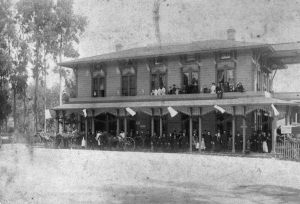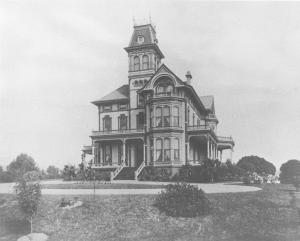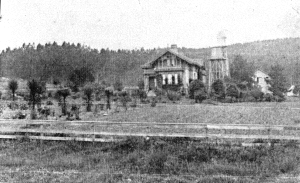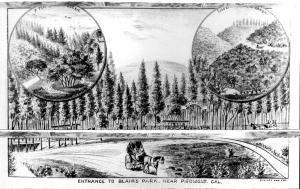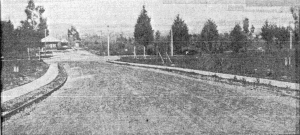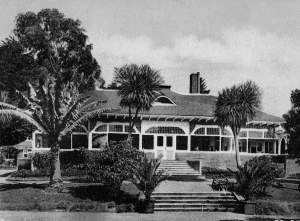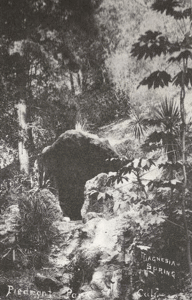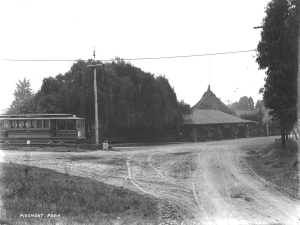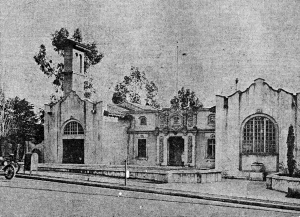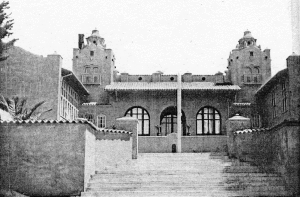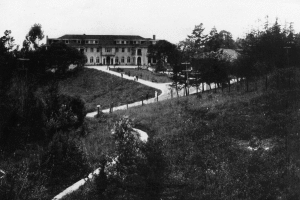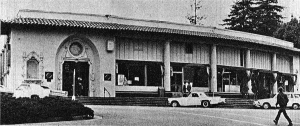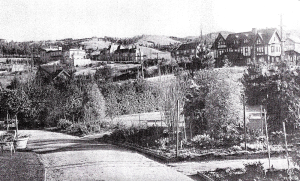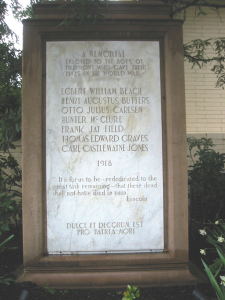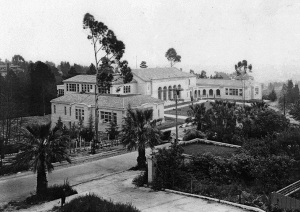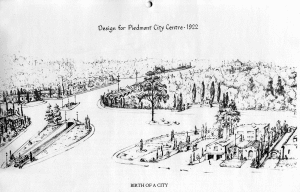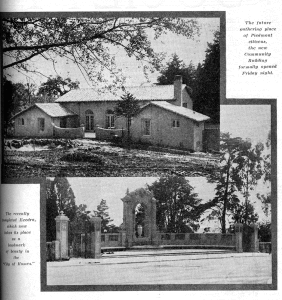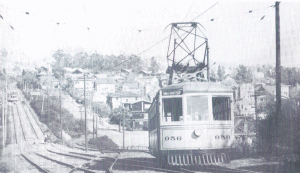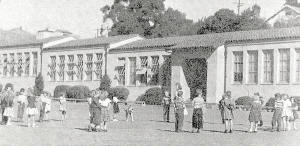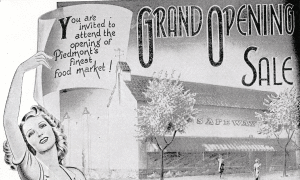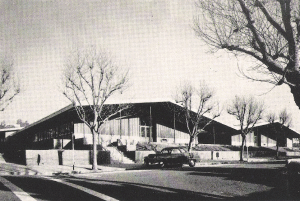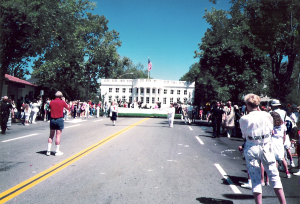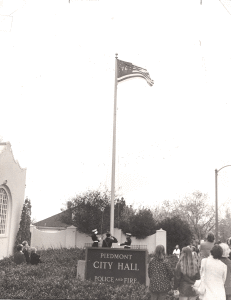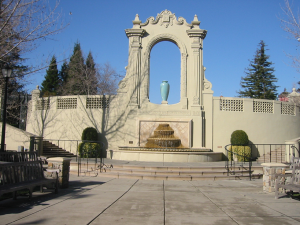From 1800 to 2007
Prepared for Piedmont’s Centennial
In 1852 Walter Blair became the first settler in the Piedmont hills. He established Blair’s Dairy at the corner of today’s Blair and El Cerrito Avenues, and his cattle grazed in pastures that ran to Grand Avenue. Blair’s Dairy supplied milk and butter to surrounding communities and San Francisco. Blair’s quarry, in today’s Dracena Park, supplied crushed rock to pave the dusty streets of Oakland and Piedmont. Walter Blair’s original cabin was on Highland Avenue which he called “Vernal Avenue” for the lush ferns and shrubs that grew there.
In the 1860s, the discovery of sulphur springs began to attract visitors to Piedmont. Mineral springs were believed to possess great curative powers, and the Piedmont Springs Hotel opened in 1871 to provide accommodations for those who came to “take the waters.” Built on the site of today’s Exedra, this grand hotel had a wide veranda, 20 bedrooms and 2 suites, 5 dining rooms, and a Grand Saloon (for men only with an elegant mahogany bar, billiard table and pot-bellied stove.) The hotel thrived until 1892 when it was destroyed by a spectacular fire.
Isaac and Sarah Requa were among Piedmont’s earliest pioneers. Isaac’s fortune came from silver in Nevada, and their estate, ‘The Highlands’, was the most impressive of the early mansions. Built on a prominent knoll, this elegant 1876 Italianate mansion had 22 rooms, and its buttercup yellow paint was visible from across the bay. As with many of these early estates, ‘The Highlands’ provided most of its own food from vegetable gardens, fruit trees, dairy cattle and chickens. On the death of Sarah Requa, the mansion was demolished in 1923, and daughter Amy Requa Long developed the estate into forty-two houses.
Piedmont’s early estates covered many acres. Hugh Craig was also one of the first pioneers in Piedmont. He owned six acres on Highland Avenue and built this home in 1879. In 1907, Craig led the fight to incorporate Piedmont as a city, and as mayor, he guided Piedmont through its first 14 years of cityhood. In 1912 Craig moved his house from this location on Highland to its present location at 55 Craig Avenue and subdivided his property.
Walter Blair opened Blair Park in the 1880s where families could “spend a pleasant day rambling in the country.” Located at the end of Highland Avenue, Blair Park had tables for picnickers, paths for wandering, and later a bandstand, Japanese Tea House, dancing pavilion, Venetian canal ride and balloon ascensions. With Montgomery Howe, Blair established the first horse car line into Piedmont, providing transportation to Blair Park and the Piedmont Springs Hotel. Many of these picnickers and hotel guests enjoyed the views and climate in Piedmont, purchased land, built homes and became Piedmont’s early residents.
Piedmont’s only industry was its “Silk Farm.” Established in 1885, the Ladies Silk Culture Society operated a 15-acre farm planted in mulberry trees near today’s Dudley Avenue and Littlewood Drive. The purpose of the “Silk Farm” was to provide self-sustaining work for young women who lived and worked in a large two story building, harvesting the mulberry leaves, feeding the silkworms who lived on the trays shown in this photo, and painstakingly unraveling the silkworm cocoons. The “Silk Farm” could not produce silk that was as inexpensive as that produced in China, and the farm closed after ten years.
In 1890, cable cars replaced Walter Blair’s horse cars and played an important role in bringing visitors and future residents into Piedmont. Powered by a steam engine that heated the Piedmont Baths, the cable car line ran up Oakland Avenue from downtown Oakland. This photo shows the cable car stopped at Oakland and Highland Avenues where passengers would disembark for the Piedmont Springs Hotel. From here, the cable car began its famous “gravity ride,” coasting down Highland Avenue to Moraga Avenue and Blair Park. At the park, the cable car turned left and coasted diagonally back toward Oakland Avenue where it picked up the cable near Carmel Avenue and resumed its trip downtown. Many of Piedmont’s early houses were built near this cable car line which provided efficient transportation to downtown Oakland and the ferries to San Francisco.
After the hotel burned, Frank C. Havens developed Piedmont Park in 1898 to continue to draw visitors and future residents to Piedmont. The popular Piedmont Park Café offered fine dining with linen draped tables and potted palms. A veranda provided fresh air dining, and the broad steps led into the park. Havens continued to add to the Park with a Japanese Tea House on the site of today’s tea house. He planted palms, orchids, cannas and other exotics along the park paths. The Maze, planted in privet in 1904 where today’s Witter Field stands, challenged visitors to find the red pagoda in the center. In 1907, Havens added the Piedmont Art Gallery to display his art collection.
The sulphur springs remained popular in Piedmont Park, and Frank Havens built a concrete faux rock folly around the lower spring. Concrete niches inside this grotto held the bubbling sulphur waters, lush ferns and a goldfish bowl. As the goldfish swam, flashes of gold sparkled in this stone grotto. A cup near the sulphur spring allowed the curious to “take the waters” as others had in the 1870s. During Piedmont’s Centennial, the Grotto was rebuilt with a new stone wall and bench. Openings in the stone wall show the original faux stone grotto.
This rare 1899 photo shows the first houses on Hillside Avenue from the west, built near the cable car line on Oakland Avenue. From left, the Barraclough house at 321 Hillside, the Channel house (demolished), the Gorrill house at 337 Hillside, the Gorrill Wedding Cottage at 345 Hillside (built for their daughter) and the Gamble house (far right, destroyed by fire and later replaced by the Kinney house that became the Recreation Center).
By 1901, the Key Route electric streetcars replaced the cable car system in Piedmont and the East Bay, and soon Piedmont had three streetcar lines. This streetcar, stopped in front of Piedmont Park, was on the Number 10 line which traveled through central Piedmont to the Fenway at Crocker and Hampton. The Number 11 ran up Oakland Avenue and through today’s Linda Park to Piedmont Avenue. The Number 12 car served Grand Avenue and traveled up Fairview to Jerome Avenue. These streetcar lines made more neighborhoods in Piedmont desirable by offering convenient, efficient public transportation. Piedmonters could catch a streetcar every 20 minutes for a ride to or from downtown Oakland or to the ferries to San Francisco. They ran every 5 minutes during the busy 5 to 6 pm hour.
Piedmont City Hall was built in 1910. After the 1906 earthquake and fire in San Francisco, many refugees fled to Oakland and Piedmont. Oakland began to annex land and threatened to annex Piedmont. In January of 1907, Piedmont residents voted to become a city, and on January 31, 1907, Piedmont was officially recognized as a municipality by the State of California. The city hall and fire department were designed by Albert Farr and held the council chamber, municipal offices and jail. The fire station had a garage, dormitories, hose drying tower and 60 foot bell tower to call volunteer fire fighters.
Other civic improvements followed. Albert Farr designed the Oakland Avenue Bridge in 1910 as a significant entrance to Piedmont with the same Spanish design as the Piedmont City Hall and the Bonita Avenue School. It replaced an old wood trestle built for the cable cars in 1890. Note the passenger waiting stations and pillars, now gone.
The Bonita Avenue School was the first public school in Piedmont. Built in 1910 and also designed by Albert Farr, it had 8 classrooms with 8 teachers teaching 8 grades, and stood where Havens School is today. Prior to this, many Piedmont students attended the Piedmont Avenue School. Ellen Driscoll was the first principal and taught here for 20 years. The school was renamed the Frank C. Havens School in 1914.
In 1913 the Lake Avenue School was built, and 4 teachers taught 6 grades and 100 students there. In 1918 the name was changed to Egbert W. Beach School in honor of California’s first officer killed in World War I and a popular Piedmont resident. Wildwood School followed in 1924.
Miss Ransom and Miss Bridges School for Girls on today’s Hazel Lane was a private school in Piedmont from 1908 to 1932, and the first school in Piedmont to have high school classes. The school offered classes from first grade through high school, dormitory facilities for 50 older girls, and outings to concerts, plays, picnics, and hiking and riding trails. Students performed an annual Shakespeare play, and many graduates went on to the University of California.
In 1912, Wallace Alexander headed a group of residents, purchased 2 acres across from Piedmont Park, and hired Albert Farr to design a commercial center. Prior to that, Piedmont was known as the “store-less city.” By 1913 Piedmont had a grocery store (later Hamby’s Market), a drug store (later Springman’s Pharmacy) and the Sweet Shop with its candy store, fountain and lunch room. A gas station and bank were added in the 1920s. In 1916, Alexander again hired Albert Farr to design the Piedmont Interdenominational Church, now the Piedmont Community Church.
In 1913, Piedmont Manor tract was one of many new developments. The house in the foreground is on Manor Drive, with York Drive and Ricardo Avenue just beyond. Houses in the upper right were built earlier, near Highland Avenue and the horse car and cable car lines. The nearby Lake Avenue School (now Beach School) was just built, and the electric streetcar line ran on Arroyo Avenue. These lots sold quickly.
In 1913, Wickham Havens listed 32 millionaires living in Piedmont claiming it per capita, the wealthiest town of its size in California. Newspapers quickly called Piedmont the “City of Millionaires.” This 1918 photo shows the neighborhood near Hampton and Sea View with large mansions and extensive gardens. Wallace Alexander’s Brown Gables is the house on the far right at the corner of Hampton and Sea View (demolished), and to the left, Samuel Taylor’s red brick Georgian mansion at 90 Sea View, and James Moffitt’s estate at 86 Sea View. The large light colored mansion on the far left was demolished in the 1930s.
As the United States entered the Great War in 1917, Piedmont’s young men answered the call to serve their country. Seven Piedmont men died in World War I. They are remembered in a marble memorial designed by Albert Farr. This memorial was originally placed in the grove of redwood trees to the east of the commercial center where it was the site of Memorial Day observances. It now stands near the entrance to the Veterans’ Building.
Egbert William Beach
Henry Augustus Butters
Otto Julius Carlsen
Hunter McClure
Frank Jay Field
Thomas Edward Graves
Carl Castlemayne Jones
In 1920, residents voted on “the two most important events” in the city’s history – to establish a high school and to acquire Piedmont Park. Piedmont High School was designed by William H. Weeks, and when it opened in 1921, it offered classes for both junior and senior high school students. Officials expected 260 students, and 325 students enrolled. There were 400 students by the end of the year. Piedmont Junior High School and the athletic field were soon added in 1924, and additions to the high school were built in 1937 and 1939.
Piedmont developed its Master Plan for the Piedmont City Center in 1922. When Frank C. Havens died, his widow decided to sell Piedmont Park. Before it could be sold to developers, school officials and the city, led by Wallace Alexander, purchased most of the park land. City officials hired Albert Farr to design a master plan with an elaborate Exedra at the entrance to the park, a new Community Hall, additions to City hall, municipal garages and a new streetcar route through a tunnel to a plaza level passenger station at the Community Hall, complete with a fountain. The plan was to be built in phases.
Albert Farr’s Exedra and Community Hall were built as the first phase of the 1922 Master Plan. Howard Gilkey designed the park’s new landscaping. The grand dedication ceremony was on April 3, 1925. Civic leaders and residents entered the park through the Exedra. Guests admired the newly landscaped park and Rose Garden as they proceeded to the Community Hall for speeches, music and refreshments. Later phases of the Master Plan were never built. School construction took priority, and the Junior High and Wildwood schools were built. Later the Depression ended all plans for grand construction.
After the construction of the Bay Bridge in 1936, the electric C Train provided direct transportation from Piedmont to San Francisco every 20 minutes. On the right, the C Train heads to its station at Oakland and Latham Avenues. On the left, the Number 10 streetcar makes its way down the tracks along Arroyo Avenue on its way to Piedmont Avenue in this 1943 photo.
Piedmont schools benefited from the Works Projects Administration building programs in 1940. WPA labor and funding enabled Piedmont to rebuild Beach School. (The new Beach School is shown in this 1950s photo.) The WPA built 28 additional earthquake-proof classrooms at Havens, Wildwood, Beach and the High School, and new auditoriums at Beach and Wildwood. In anticipation of a new elementary school in east Piedmont, the WPA built a retaining wall at the corner of Hampton and LaSalle creating level ground for a future school and playground. The school was never built, and today the Piedmont Sports Field benefits from this retaining wall.
Piedmont’s commercial center increased in 1940 when the City Council reluctantly agreed to permit commercial development at Highland and Vista Avenues. Safeway Stores joined the Flying A service station at this corner. The original Safeway building now houses Mulberry’s Market and Citibank.
As the country entered into World War II, Piedmonters supported the war effort at home through clothing donations, Red Cross volunteer work, scrap metal drives, rationing, victory gardens, Civil Defense programs, and participating in black outs. The Exedra became a temporary war memorial. Large signs posted at the Blue Vase listed Piedmonters in the war. One side listed those fighting for our country. The other side listed those who died in the war. Residents sadly noted as names were shifted from one side to the other. Piedmont lost 50 young men in World War II. They are remembered on the plaque on the Veterans’ Building.
The Board of Education replaced the former Bonita Avenue School as it was “inadequate as an educational building and potentially hazardous in case of a severe earthquake.” School officials hired Carl I. and John C. Warnecke to design the new school, and the new Frank C. Havens School was dedicated on March 8, 1955. It held a kindergarten, 11 new classrooms, library, cafeteria and administration wing.
Many of Piedmont’s traditions began in the 1960s. In 1963, a biology teacher began a classroom exercise on birds. Students studied a bird, gave a report and mimicked its bird call. This exercise was wildly popular and soon expanded to the entire student body. It became the Leonard J. Waxdeck Birdcalling Contest, and winners appeared on national television.
The Piedmont Beautification Foundation began making improvements to Piedmont’s parks in 1964, starting with landscaping the Fenway, Cherry Walk and the Community Center. The first Holiday Tree lighting was in 1968.
Piedmont’s 4th of July Parade began in 1965. Dick Johnson, chairman of the Recreation Commission, began the parade after noticing a low in patriotism during the Vietnam War years. From the beginning, Piedmont’s parade included marching bands, antique cars, Bag Pipe bands, neighborhood participation (sometimes with very elaborate floats as seen in this float of the White House) and ended at the park with speeches and music.
Piedmont celebrated the nation’s Bicentennial on several occasions in 1976. The Bicentennial flag was raised over City Hall, the Bicentennial Wall was built and the Bicentennial Oak tree was planted in the park. The 4th of July Parade had an especially patriotic theme with Benjamin Franklin as the speaker. The Piedmont Beautification Foundation funded the dry creek landscaping at the new Japanese Tea House as its Bicentennial project.
As Piedmont approached its 100th anniversary, play fields were added and improved. Coaches Playfield at Moraga Canyon was dedicated in 1994. Witter Field was re-dedicated as Witter Sports Complex in 1998 with a new synthetic turf field for football and soccer, new track, new baseball and softball fields, and a new field house. The William F. Kennelly Skate Park opened in August of 2001, and the Dracena Park Tot Lot opened on March 11, 2006.
Improvements to Piedmont Park began in 1987 with the city’s Main Park Renovation Plan. Undesirable trees and shrubs were removed to let in more light. Park paths were repaved. High School students planted native plants along the creek. With a combination of public and private funding, the Overlook was built, Main Park Tot Lot installed, and the Exedra renovated. Piedmont Beautification Foundation reconstructed the bus shelter, planted the Native Plant Garden and began its Memorial Bench program. The Exedra Park Plaza and Fountain were completed in November of 2006. On January 31, 2007, Piedmont celebrated its Centennial with the newly restored Sulphur Springs Grotto in the park and the History Trail signs telling the story of Piedmont Park.


